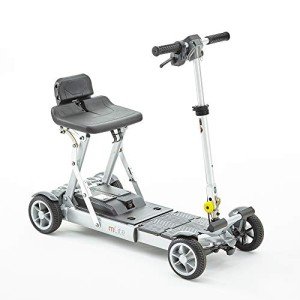The Reason Why Mobility Devices Is Greater Dangerous Than You Think
Understanding Mobility Devices: Enhancing Independence and Quality of Life
In today's busy world, the desire for mobility is universal. However, specific medical conditions or age-related difficulties can prevent motion, leading to an ongoing search for help. Mobility devices function as essential tools to boost self-reliance, enhance lifestyle, and allow people to engage fully in their communities. This post provides an extensive overview of mobility devices, including their types, functions, selection criteria, and more.
Types of Mobility Devices
Mobility devices range from easy aids to intricate devices, tailored to satisfy numerous needs. Below is a table summarizing common types of mobility devices:
Type of Device
Description
Suitable For
Walkers
Four-legged assistance devices that supply remarkable stability while walking.
Individuals requiring additional assistance.
Walking canes
Single or three-legged sticks that improve balance and assistance walking.
Those with slight mobility troubles.
Wheelchairs
Seats installed on wheels, readily available in handbook and electric variations.
Individuals with minimal or no mobility.
Scooters
Electric vehicles developed for outdoor use and ease of navigation.
Those who can't stroll fars away.
Crutches
Devices that help people move weight far from a hurt leg.
People recuperating from leg injuries.
Rollators
Walkers with wheels, seats, and brakes for boosted mobility.
Users needing rest choices while strolling.
Raise Chairs
Reclining chairs that assist users in standing up and sitting down.
Seniors or those with mobility constraints.
Mobility Scooters
Small electric automobiles for restricted mobility, typically utilized outdoors.
Individuals needing help over fars away.
Key Features of Mobility Devices
When selecting a mobility device, several key functions ought to be considered to ensure optimum performance and ease of usage:
- Weight Capacity: Understanding the gadget's weight limitation is essential for security and effectiveness.
- Adjustability: Devices should be adjustable in height and width to fit the user easily.
- Mobility: Lightweight and foldable choices are vital for users who travel or need transport.
- Stability and Safety: Look for functions like anti-tip wheels and sturdy structures to improve security.
- Alleviate of Use: Simple mechanisms and easy to use designs can make a substantial distinction in daily usage.
- Comfort: Ergonomic designs and cushioned seats can enhance the user experience.
Selecting the Right Mobility Device
Picking the ideal mobility device can be a difficult job. Here are some steps to assist the decision-making procedure:
- Assess Needs: Evaluate the person's mobility obstacles and daily activities.
- Seek advice from a Professional: Engage healthcare specialists who can supply recommendations based on the individual's physical condition.
- Trial Options: If possible, trial various devices to determine comfort and functionality.
- Evaluation Budget: Consider the expense of the gadget, including any extra functions or modifications needed.
- Research Options: Determine the very best brand names and models by checking out reviews and comparisons.
Table: Comparative Analysis of Popular Mobility Devices
Device
Advantages
Downsides
Walkers
Exceptional stability, promotes walking.
Large, may restrict movement in small spaces.
Canes
Lightweight, improves balance.
May not supply adequate assistance for severe mobility concerns.
Wheelchairs
Suitable for those with considerable mobility constraints.
Can be cumbersome, particularly in indoor environments.
Scooters
Great for outdoor usage, simple to maneuver.
Limited indoor use, heavier.
Rollators
Provides rest alternative, easy to move.
May require more area than traditional walkers.
Lift Chairs
Comfortable, helps transition from sitting to standing.
More pricey, larger footprint.
Regularly Asked Questions (FAQs)
1. What is a mobility device?
A mobility gadget is any tool created to assist people in moving and browsing their environment. This consists of walkers, wheelchairs, scooters, and crutches.
2. How do I know which mobility gadget is best for me?
Consider your particular mobility challenges, physical capabilities, and lifestyle needs. Consulting with healthcare professionals can also offer tailored recommendations.
3. Are mobility devices covered by insurance?
Lots of insurance strategies, consisting of Medicare, might cover specific mobility devices. It's important to contact your insurance coverage supplier for particular coverage information.
4. Can folding mobility scooters rent a mobility gadget rather of buying one?
Yes, many medical supply stores and pharmacies use rentals for mobility devices. This option is helpful for people with short-term mobility issues.
5. How can I maintain my mobility device?
Routine upkeep is essential. It includes cleaning the gadget, examining for wear and tear, and guaranteeing all parts are working properly.
The Impact of Mobility Devices on Quality of Life
Mobility devices considerably enhance the lifestyle for people with limited mobility. They foster self-reliance, encourage social interaction, and improve access to essential services and recreational activities.
- Increased Independence: Users can navigate their communities, go to occasions, and participate in hobbies without relying on others.
- Social Engagement: Mobility devices help with participation in social events, therefore combating sensations of seclusion.
- Improved Safety: Devices offer stability and decrease the danger of falls, promoting user confidence.
Mobility devices are more than simply tools for motion; they are entrances to independence and quality living. By understanding the different kinds of mobility aids available, their key functions, and considerations for choosing the ideal device, individuals can make educated choices about their mobility needs. Eventually, the best mobility device can cause a more active, fulfilling life. Whether it's a walker, wheelchair, or scooter, the best choice contributes substantially to boosting the mobility and independence of users.
